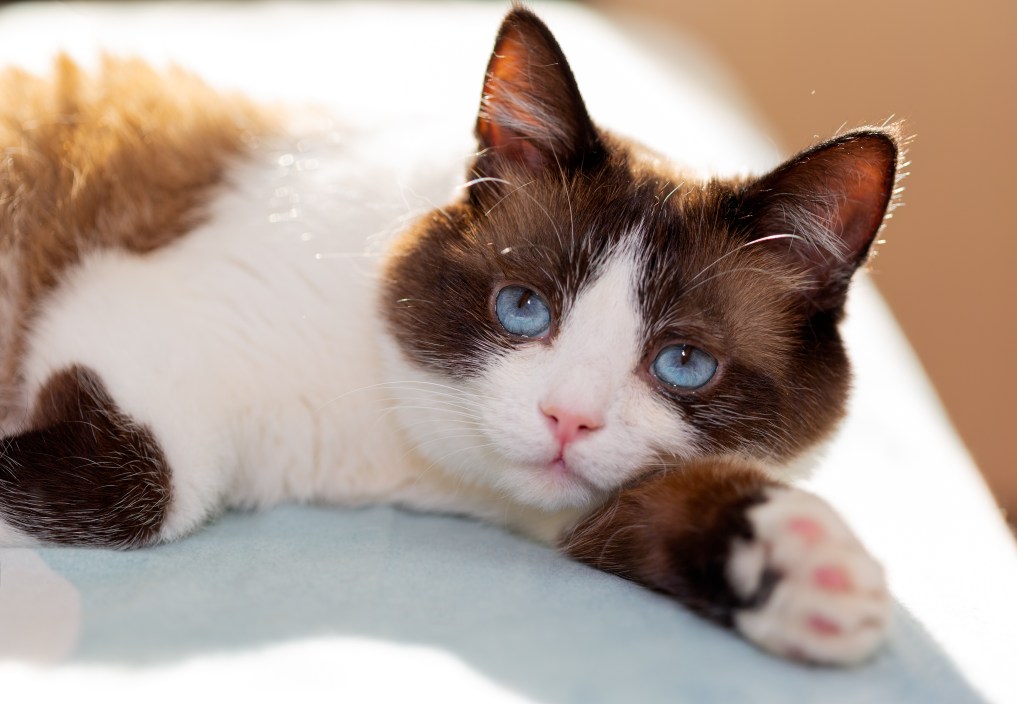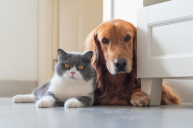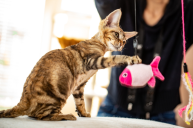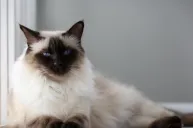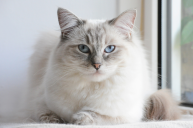If you're lucky enough to have a snowshoe cat in your life, you know exactly how special these beautiful creatures are. From their quirky, friendly personalities to their signature white feet, kitties of this affectionate cat breed are sure to thaw out the coldest of hearts with their warm cuddles and silly antics.
But where did these playful felines come from, and how do you properly care for one? With roots in the American shorthair and Siamese cat breeds, snowshoe cats have an interesting story.
Breed History of the Snowshoe Cat
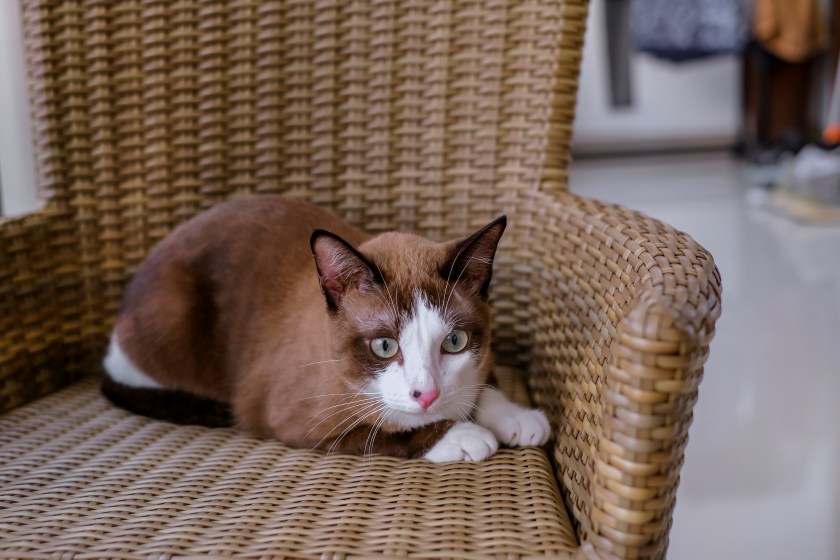
Getty Images, Kanawa_Studio
Evidence of Siamese cats with distinctive white paws dates back to Victorian times, according to the American Cat Fanciers Association (ACA). The first known modern attempt to breed snowshoe cats began with a white-footed Siamese named Silver Laces in the 1950s. But the breed wasn't established until the 1960s, when Dorothy Hinds-Daugherty, a Siamese cat breeder in Philadelphia, intentionally created a "moderate, white-footed" Siamese-like cat that she dubbed "snowshoe" by breeding purebred Siamese with an American Shorthair cat, then back with a Siamese, tapping into the breed's recessive genes.
Daugherty and her Kensing Cattery developed the breed standard for the cat and approached the Cat Fanciers Federation (CFF), getting approval to show the cats in exhibitions. Eventually, Daugherty turned her shoeshoe operation over to Vikki Olander with the Furr-Lo Cattery in Virginia. Olander advanced the breed, creating a comprehensive standard and getting it recognized with the CFF and ACA for "experimental" registration. But everything stalled for these cats in 1977, with only four snowshoes registered with the associations.
The breed was pushed forward by two Ohio breeders, Jim Hoffman and Georgia Kuhnell, who were put in touch with Olander. Eventually, they recruited more breeders, and the snowshoe cat was recognized by the CFF for Championship status in 1982. Soon after, she was able to get the showshoe cat accepted into The International Cat Association (TICA), which granted the breed Champion status in 1994.
Snowshoe Cats' Personality
Snowshoes are very athletic and are known for their muscular bodies. Generally, a healthy cat will weigh between 7 and 12 pounds, with the males being larger than the females. On average, snowshoe cats live 14 to 20 years.
Much like their Siamese ancestors, these cats are intelligent and sociable. Their amiable cat personality makes them a wonderful choice for a family cat as they usually get along with young children and dogs. Initially, they don't like guests in their home, but it doesn't take long before they warm up to them. The Snowshoe cat will play any game you want—even fetch—and will follow you through the house, filling your ears with a chorus of meows.
But there's a downside to their social nature: Snowshoe cats don't like being left alone for long periods of time. These cats would much rather be with their humans, giving them cuddles. Thankfully, they're very accepting of other cats and dogs and do well with a companion to keep them entertained during the day.
Snowshoe Cats' Appearance and Care
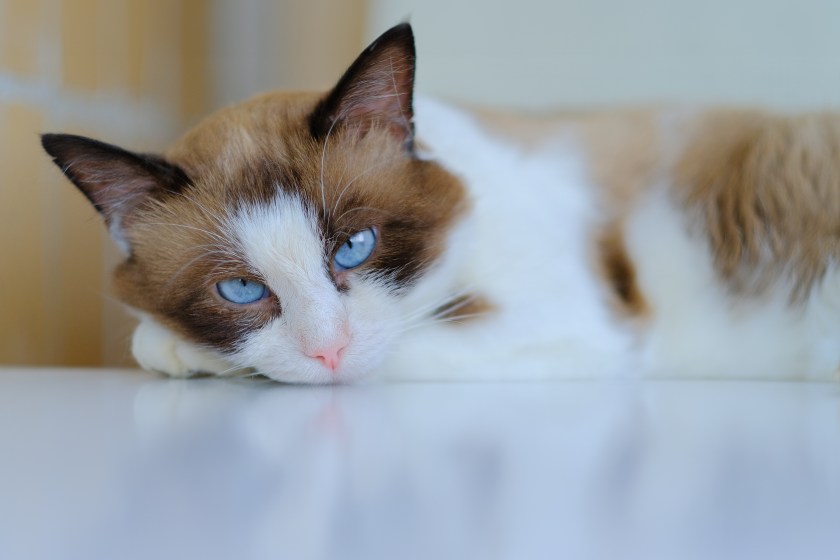
Getty Images, Larisa Kuzmenko
Snowshoe kittens are born all white, with their point color coat pattern showing up within a few weeks. A pointed cat has a light-colored body that is punctuated by dark areas (points) in any of many colors, such as chocolate, light cream, red, lilac, blue, fawn, seal, and cinnamon. The point locations are ears, tail, a raccoon-like mask around the eyes, and legs. In addition to their white mittens, snowshoes are known for having a "V" of white fur between their eyes, which are always some shade of blue.
Thanks to their short coat and low shedding, they're often thought of as hypoallergenic, but they're not. Their short hair needs to be brushed twice a week, much like other cat breeds, and their nails should be trimmed once a month. It also important to clean a cat's ears as needed and brush their teeth once a week. Setting up a grooming routine right away makes it easier for your new cat to adjust to the process, even if they don't like it.
Snowshoes aren't known for any breed-related health issues. As with any pet cat, TICA recommends that cats receive all of their vaccinations and have regular vet checkups.
Famous Snowshoe Cats
Despite being a relatively rare cat breed, a handful of snowshoe cats have become celebrities. One of the most famous is Grumpy Cat. While her parents were American shorthairs, and her owners say she was a mixed breed, many people think she had some snowshoe cat in her ancestry.
Another famous cat is more infamous: Dusty the Klepto Kitty was well known for one skill—cat burglary. His top-level dexterity earned him a guest spot in 2011 on the "Late Show with David Letterman." At that point, the kitty thief had a haul of household items, including 213 dish towels, 100 gloves, 73 socks, 40 balls, eight bathing suits, and a dog collar. All of the items were stolen from his San Mateo neighbors. He ferreted his loot away, bringing it home as a prize for his cat parents.
Finally, Instagram-famous snowshoe Burton the Cat uses his notoriety to help orphaned kittens and raise awareness on the importance of adopting unwanted cats. He walks on a leash, educates the public about his own cat rescue organization, Burton's Pride, and isn't afraid to hop aboard a flight on Southwest.
How to Get a Snowshoe Cat of Your Own
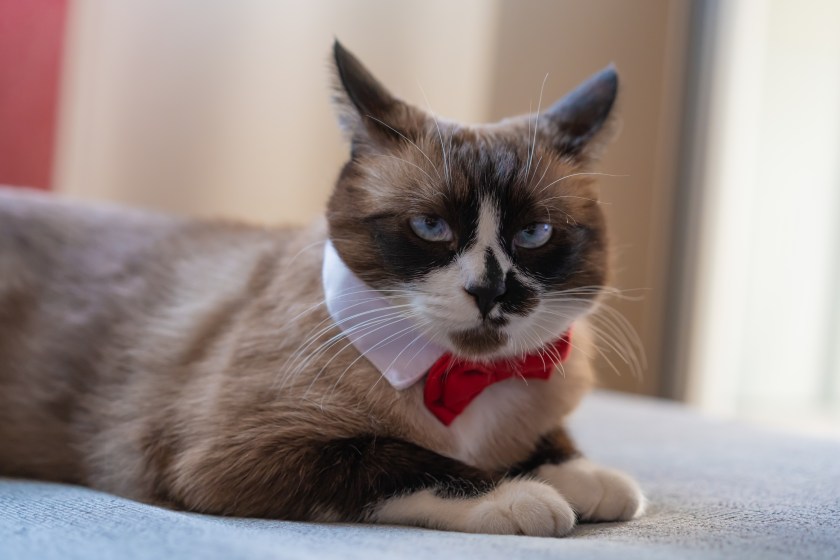
Getty Images, Eva Diana Lopez
It's rather difficult to breed the snowshoe cat, which is why it took a while to establish the breed in the first place. Most often, they're bred snowshoe to snowshoe as per the cat's standard, but a successful litter relies on recessive traits to give them their white boots. Snowshoe cats can be crossbred with Oriental shorthairs to help bring out the gene.
Therefore, if you have your heart set on a snowshoe, the best way to get your own is to find a reputable breeder. Contacting organizations like CFF and TICA can help you locate reputable breeders in your area.
READ MORE: Persian Cats Are Like Little Kings and Queens
